Kodak EasyShare P880Kodak re-enters the enthusiast market with a great 8-megapixel offering<<Reference: Datasheet :(Previous) | (Next): P880 Sample Images>> P880 IMATEST ResultsReview First Posted: 11/23/2005 |
Detailed analysis of the Kodak EasyShare P880 images, from Imatest(tm)
I've recently begun using Norman Koren's excellent "Imatest" analysis program for quantitative, thoroughly objective analysis of digicam test images. I highly commend it to our technically-oriented readers, as it's far and away the best, most comprehensive analysis program I've found to date.
My comments below are just brief observations of what I see in the Imatest results. A full discussion of all the data Imatest produces is really beyond the scope of this review: Visit the Imatest web site for a full discussion of what the program measures, how it performs its computations, and how to interpret its output.
Here's some of the results produced by Imatest for the Kodak P880:
Color Accuracy
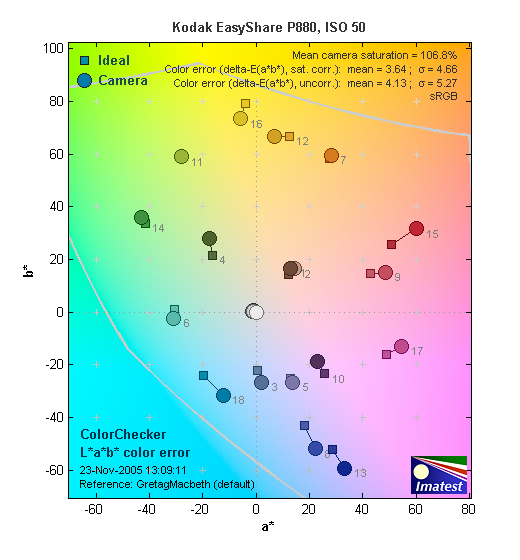
Color on the P880 was excellent, striking just the right balance (to my eyes, anyway) between highly accurate but drab-looking or oversaturated. Many colors have a slight saturation boost, and the reds that most other cameras grossly oversaturate are held in check nicely. Hue accuracy is excellent as well, the one significant hue shift being the shift of cyans towards pure blues, a very common tactic in digital cameras, intended to improve sky colors. Average saturation was 106.8% (oversaturated by 6.8%), average "delta-E" color error was an incredible 3.64 (hue error, after correction for saturation), easily putting the P880 among the most color-accurate cameras we've ever tested.
Color Analysis
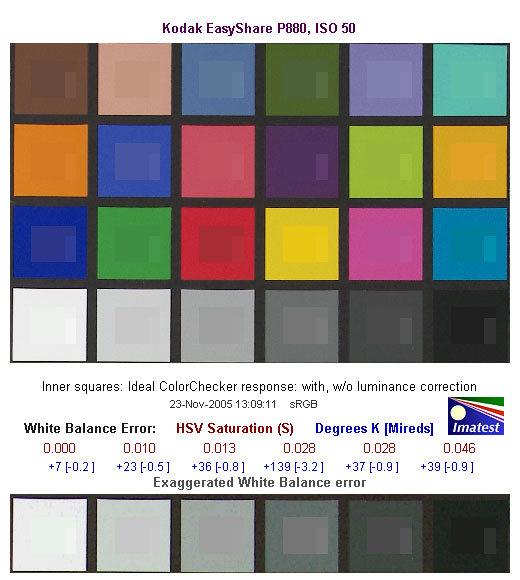
These images show the color behavior of the P880 directly. In each color swatch, the outer perimeter shows the color as actually captured by the camera, the inner square shows the color after correcting for the luminance of the photographed chart (as determined by a 2nd-order curve fit to the values of the gray swatches), and the small rectangle inside the inner square shows what the color should actually be, based on perfect rendering to the sRGB color space The major differences in the samples above are in luminance, it's clear that the colors themselves are highly accurate.
Gray Patch Tone and Noise Analysis
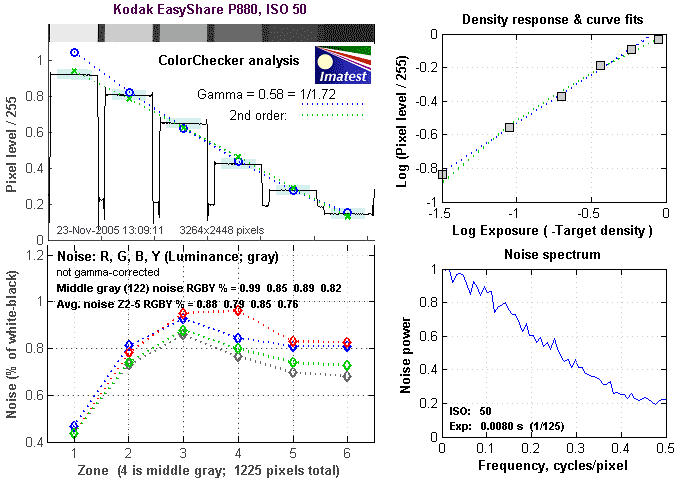
There's a lot in this particular graph, a lot more than I have room to go into here. Bottom line, the P880's noise levels at low ISOs are low, comparable to other cameras that it competes with. At low ISO, the noise also has a lot of high-frequency content, which gives it a very fine grain pattern, making it less objectionable than it might be otherwise. This characteristic holds up to ISO 400. The camera will only shoot at ISOs 800 and 1600 at a resolution of 1024x768. There, the noise frequency spectrum looks a lot the same as shown above, but to achieve it, the camera flattens out a tremendous amount of subject detail, making those ISO settings all but unusable.
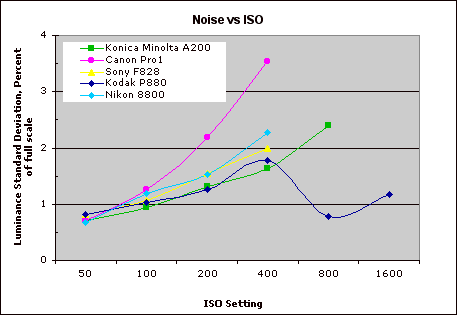
This chart compares the P880's noise performance over a range of ISOs against that of other cameras it nominally competes with. (Although it sells for less than all the cameras shown here, in some cases for much less.) As you can see, the P880's noise levels are in line with the best of its competition at ISOs from 50-400. From the chart, you'd suspect something odd was going on at ISO 800 and 1600, and it is: As mentioned before, the P880 flattens out a tremendous amount of subject detail for the sake of achieving low noise figures, producing images that are "clean," but that look like they were run through a heavy-handed median filter in Photoshop(tm). For any practical applications, forget about ISOs higher than 400 with the P880.
The chart above shows consolidated results from spatial frequency response measurements in both the horizontal and vertical axes. The "MTF 50" numbers tend to correlate best with visual perceptions of sharpness, so those are what I focus on here. The uncorrected resolution figures are 1469 line widths per picture height in the horizontal direction (corresponding to the vertically-oriented edge), and 1443 along the vertical axis (corresponding to the horizontally-oriented edge), for a combined average of 1456 LW/PH. Correcting to a "standardized" sharpening with a one-pixel radius increases this number a lot, to an average of 1895 LW/PH. The uncorrected numbers are on the low side for an 8-megapixel camera, the corrected numbers are about right.
For the real techno-geeks, the two plots below show the actual edge response of the P880, for horizontal and vertical edges. I'm frankly a little puzzled by these plots, because they don't show the sharpening artifacts that we saw so clearly in some of our test pictures. (Here, those artifacts would appear as an extra "bump" next to the edge, on the right-hand or brighter side.) The uncorrected edges here are almost perfect, with very smooth profiles, and no hint of oversharpening. It's possible that the P880's edge enhancement algorithms have been tweaked to be color-dependent, not producing halos around edges with neutral color. Whatever the case, in real-life situations, we definitely found the P880's default sharpening to be somewhat coarse and heavy-handed, to the point that we recommend shooting with the camera's sharpening set to its low option, and then sharpening post-exposure in Photoshop or other imaging software.
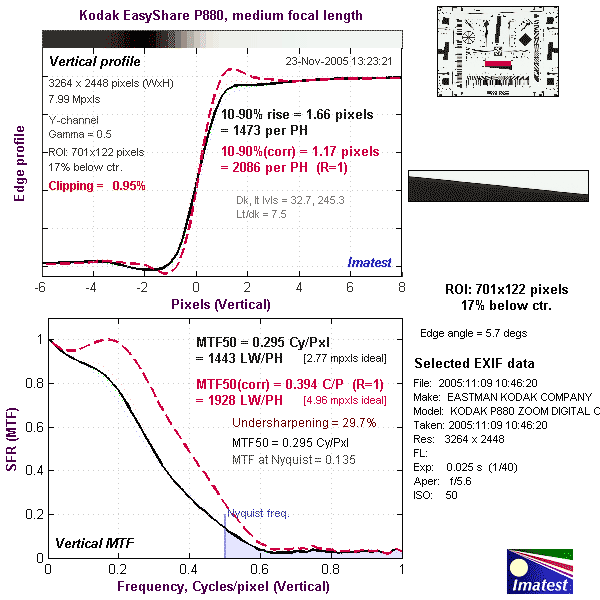
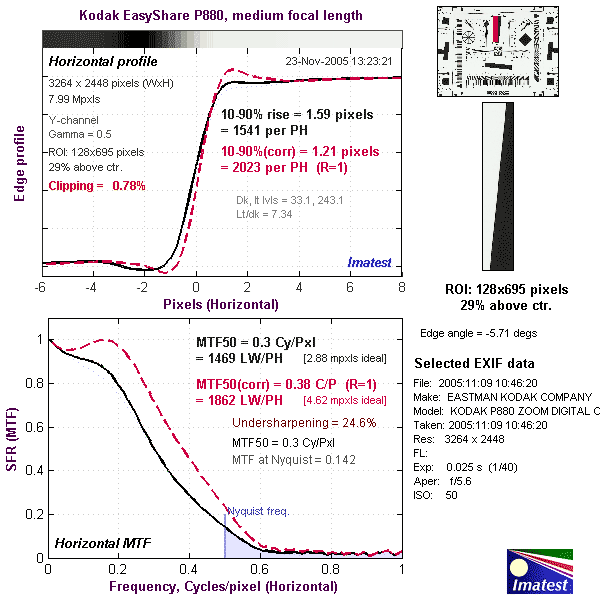
Reader Comments! --> Visit our discussion forum for the Kodak EasyShare P880!
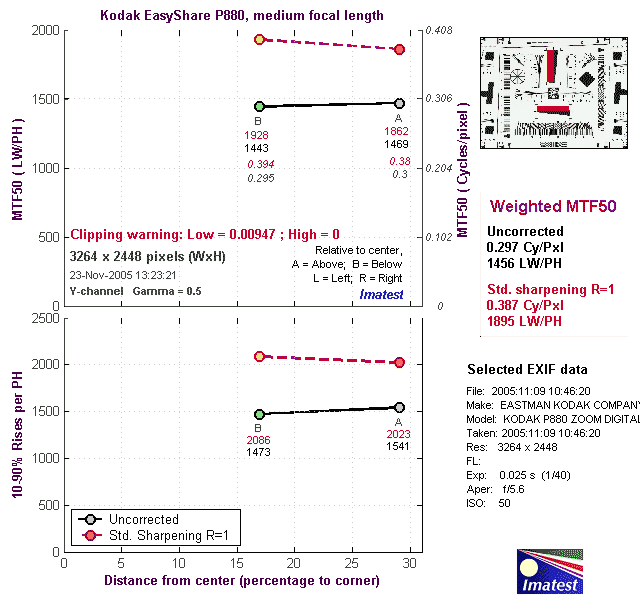

Follow Imaging Resource: